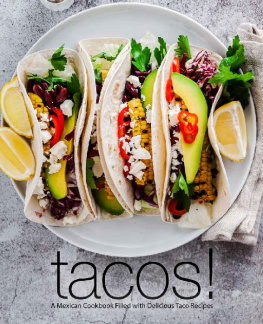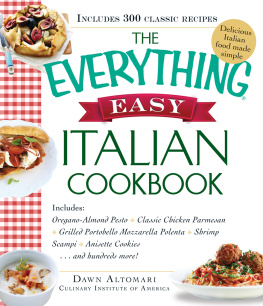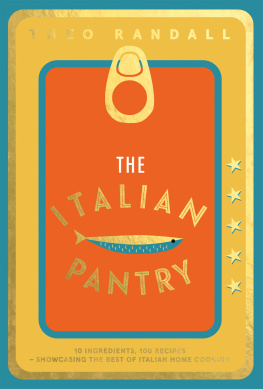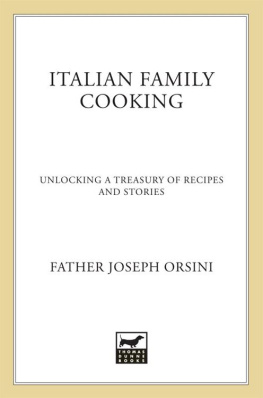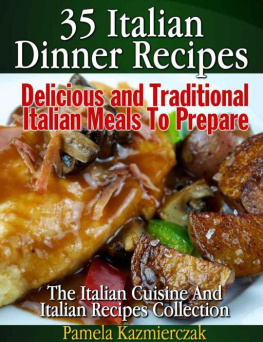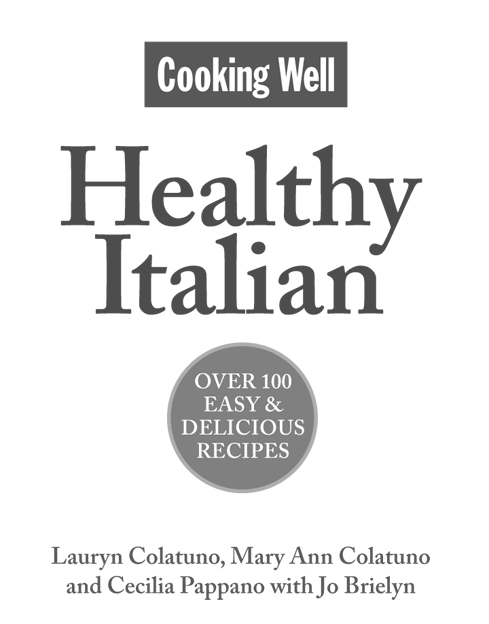
Hatherleigh Press is committed to preserving and protecting the natural resources of the earth. Environmentally responsible and sustainable practices are embraced within the companys mission statement.
Visit us at www.hatherleighpress.com and register online for free offers, discounts, special events, and more.
Cooking Well: Healthy Italian
Text copyright 2014 Hatherleigh Press
All rights reserved. No part of this book may be reproduced, stored in a retrieval system, or transmitted, in any form or by any means, electronic or otherwise, without written permission from the Publisher.
DISCLAIMER
This book offers general cooking and eating suggestions for educational purposes only. In no case should it be a substitute nor replace a healthcare professional. Consult your healthcare professional to determine which foods are safe for you and to establish the right diet for your personal nutritional needs.
Library of Congress Cataloging-in-Publication Data is available upon request.
ISBN 978-1-57826-482-7
eBook ISBN: 978-1-57826-483-4
All Hatherleigh Press titles are available for bulk purchase, special promotions, and premiums. For information about reselling and special purchase opportunities, please call 1-800-528-2550 and ask for the Special Sales Manager.
Cover and Interior Design by Nick Macagnone
Photos on by Porto Bay Events used under the Creative Commons Attribution License 2.0.
Photo on used under the Creative Commons Attribution License 2.0.
v3.1_r1
Contents
C HAPTER 1
The History of Italian Cuisine
T he delicious taste of Italian cuisine has become one of the most popular food choices for people all over the world, and its easy to see why. With so many clever and easy-to-prepare combinations of zesty sauces, garden vegetables, delectable cheeses, and fresh meat and seafood, Italian cuisine contains some of the most varied and satisfying dishes in the world. The delightful tastes, coupled with the simplicity of ingredients that Italian dishes are known for, are what make Italian cuisine an extremely appealing option in many homes. Italian cuisine promotes simple cooking, concentrating on unique flavors as well as the appearance and texture of each ingredient used. Olive oil is not simply oil. Garlic, tomatoes, and vegetables must be fresh. Traditional Italian recipes illustrate that creating healthy and mouthwatering dishes is all about the quality of the ingredients you use, not the quantity of them.
Even the mere mention of Italian food is enough to conjure up images of heavy, fattening pasta dishes, loaded with meat, cheeses, and thick tomato- or cream-based sauces. But the truth is that, while many Italian restaurants in the United States serve this sort of fare to their customers, this is not typical of the traditional cuisine found in Italy.
In order to better understand the eclectic origin and makeup of traditional Italian cuisine, it will be helpful to know a little background of the history of Italy itself. Although Italy is still fairly young as a country (at just over 150 years old), the region itself is very old. Prior to becoming its own country, the region of Italy was sectioned into kingdoms, princedoms, dukedoms, republics, and papal areas. The inhabitants of those separate areas had little contact with one another, so recipes and ingredients were not shared among the people.
The varying climate and geographical differences among the regions in Italy have impacted the ingredient choices as well. The Italian people of each region gravitate toward the foods that are in season and readily available to them for everyday cooking. In the northern plains of Italy, pastures and cows are plentiful, so beef and veal are the staple meats found in northern-inspired dishes. Of course, where there are plentiful dairy cows, ingredients such as milk, butter, and cream are readily available and frequently incorporated into foods. Dishes prepared in the mountainous regions of southern Italy, by contrast, have goat, lamb, pork, and chicken as the main meat sources. Pecorino cheese, which is made from sheeps milk, is also used more often.
Italian cooking has also been affected by the cuisines of several cultures, such as those of the Etruscan, Greek, Roman, Moorish, and Arabic civilizations. Before Italy became its own nation, it was ruled and inhabited by a variety of empires, the influences of which are evident in everything from architecture to the history of Italian food. Drawing on culinary influences from such varied sources, Italian cuisine had evolved many times over before becoming the popular dishes that we know and appreciate today.
Here are a few of the influential cultures that have contributed to the development and transformation of Italian cuisine throughout the centuries.
Etruscans: The most important contribution the Etruscans made to Italian cuisine was pulmentum. Pulmentum is a mushy, grain-based dish that is in essence a type of porridge. It originally served as a predecessor to polenta, which is a cornmeal-based porridge that is popular throughout Italy.
Greeks: The Greek nation introduced fish chowder to Italy (called bouillabaisse in France and brodetto in southern Italy).
Romans: During the time when Rome maintained control of Italy, the Roman Empire introduced exotic ingredients and spices such as ginger, pepper, and salt to the inhabitants of the Italian peninsula.
Moors: The use of couscous, citrus fruits, and almonds in recipes were introduced into Italian cuisine by the Moors.
Arabs: The dried pasta widely used in Italy and most Italian cuisine today actually originated with the Arabic population, which was especially influential in Sicily and the southern parts of the Italian mainland.
Italian Cuisine from Region to Region
Traditional Italian cuisine varies widely from region to region. Italy is comprised of 20 regions, each with their own distinct characteristics. In towns and villages across the country, Italians create the same dishes, each with its own variation or flair to mark it as distinct to that region. Each region generally also has a dish that is its prized specialty. Below are a few of the regions in Italy and the foods most often associated with them.
Tuscany
Recipes for the region of Tuscany generally have a blend of vegetables, white beans, saltless bread, and fruity olive oil. Popular spices in Tuscan recipes are thyme, rosemary, and fennel. They also use sharp, salty cheeses from sheeps milk to flavor their pastas, salads, and savory pies. Tuscan dishes, like their famous hearty soups, often include rice or risotto. Ravioli and tortelli filled with ricotta cheese are premier among the regions classic stuffed pastas.
Sicily
Sicily, the largest island in the Mediterranean, is the home of


